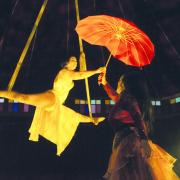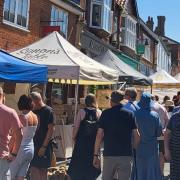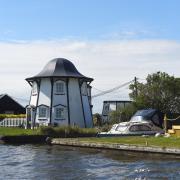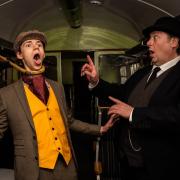Norfolk-based artist Roger Law’s creative talents stretch way beyond the Spitting Image puppets which made him a household name. Dominic Castle met him at his Wells-next-the-Sea home

We have the celebrated Cromer crab to thank for the latest exhibition to grace the Sainsbury Centre, apparently.
Roger Law: From Satire to Ceramics came about after a series of lunchtime meetings between the Norfolk-born artist, who made his name with TV’s Spitting Image, and Professor Paul Greenhalgh, the centre’s director.
“It was basically a lot of Cromer crab lunches… I started to wonder if he only liked me for my crab lunches,” says Roger at his Wells home. “He came with all sorts of ideas. What was difficult, not just for him but for me, was what aspect do you do? I’ve been an illustrator, I’ve been a sculptor, modeller, I’ve made puppets, I’ve done woodcuts, I’ve always drawn – that holds it together – and now I make ceramics.

“Greenhalgh said: ‘We’ll do it all.’”
The result is a sensational showcase of Roger’s versatility. There is a line-up of Spitting Image puppets, grotesques all, brilliant caricatures, a latex Donald Trump, delicate watercolours and drawings and magnificent ceramics, from small chargers to exquisitely carved pots big enough for Roger to hide in – and he stands well over six feet in his socks.
It is a fitting retrospective on a career which began when a young Roger, realising that the black soils of the pan-flat Fens were not going to be enough for him, enrolled in art college on a scholarship. He excelled at caricature and his art career saw his work appearing in The Observer, The Sunday Times, The New York Times, and Der Spiegel.

He worked with the legendary Peter Cook for a spell. “We were at art school at the same time. I got a job at his Establishment Club doing silly drawings and we did a satire page cartoon for The Observer called Almost the End. It was very aptly named because it ran for six weeks then [David] Astor, the editor, decided he didn’t need these rude people any more!”
In 1984 he and Peter Fluck merged their talents and Spitting Image burst on to the small screen. For 13 years its joyfully ugly latex puppets took down the day’s establishment figures with coruscating of-the-moment satire. Roger loved it.
“If you got it right and it was topical and it was funny and it also had underlying meaning, you couldn’t beat it. And people forgive you anything, because news came up on a Friday and they saw it in the comment on a Sunday,” he says. “Lots of people thought it was over the top, politically incorrect and downright unpleasant but nobody in my village thought that. They loved it.”

It was hard graft though, and despite its enormous success was not a gateway to riches for Roger and Peter. “That was entirely our fault because we were so wrapped up in what we did – we spent the money on the show. We were not businessmen,” he says. He still keeps in touch with Peter Fluck, now an artist living and working in Cornwall.
When the show left our screens in 1997 Roger, exhausted, moved to Australia and reconnected with nature, travelling around the great continent and drawing and painting what he saw. “It’s like a very exotic Fens; you wouldn’t believe how many wetlands there are in Australia. They think it is all red desert but it isn’t so.”
He was aware of the powerful influence Asian culture exerts in Australia, and while he was contemplating working more intensively in ceramics he visited China’s porcelain city, Jingdezhen.

“I went first in 1997; I just took one look and thought ‘I can’t deal with this.’ Lots of roads were just mud, it rains a lot and it was such a cultural shock that I didn’t want to know about it. Then eventually a Chinese Australian friend said ‘you should go and work there Roger, and I’ll come with you’. That was a whole different ball game because I had the key to the door.”
He introduced Roger to the factories, small family-run affairs, and work began on his vision of giving his drawings of Australia’s flora and fauna shape in porcelain. He says while the skills of the craftsmen put him in mind of the heyday of Stoke-on-Trent, the work ethic was closer to home.
“When I first went there it took me back to my childhood; it was like the Fens in the 50s, everybody worked. The conditions were pretty crap but the excitement used to cancel out the discomfort.”

His work failed a lot to start with; big pots representing weeks of work exploding in kilns, or failures with glazes. He also had a job to convince his potters to do what he wanted. “When I first started they would say ‘why should we do something we’ll never use again?’ My work stylistically leans towards China but they don’t carve so deep and don’t make it so graphic.”
He had to learn how to work the Chinese way. “When I’ve worked on something and it is destroyed I can be pretty volatile so get a bit shouty about it. Then my friend said ‘you don’t want to do that because they will agree with everything you say and hate you secretly.’ They’re very civilised!”
In a land of slight, mostly dark-haired people, Roger, over six feet tall, built to match and with a big white beard, attracts attention. “They are refreshingly politically incorrect because they’re not mealy-mouthed about it. I know they call me ‘Hairy Monkey’ because I had it translated!” he laughs.

He built strong bonds with the craftsmen – “They get fond of you because you work alongside them” – and now works with Mr Wu Song Ming. “He doesn’t speak English, I have no Mandarin, he has never seen the sea. But we spend hours working on stuff...”
The ‘stuff’ he creates is a feast of beautiful pots, chargers and plates, many adorned with sealife. Some of the pots are huge, over six feet high and weighing half a tonne; they are made even bigger but porcelain shrinks by around a third. Many of the works are glazed in celadon, the exquisite shade of jade that characterises much Chinese ware.
The humidity, heat and dust of Jingdezhen makes it a tough environment to work in and Roger is there for stints of up to five months. “Last time I went I found it quite difficult. When you have exhibitions and a deadline, at my age, wherever you live, it becomes pressurised. They’re not crazy about health and safety either, which I quite like. You can’t wear a mask, which you should do, because it is so tropical that you put this thing on your face and its like breathing through a wet flannel.”

He has also had to accept that his work will be copied. “I made these bowls with two mudskippers in the bottom and a sea pattern. I knew they would sell. I took them away from the factory but in all the excitement I left the press moulds there.
“Later we went to the antique market – they were selling my bowls! I confronted this bloke and he roared with laughter. There is no real concept of copyright. They steal from each other – it is just being a better businessman as far as they’re concerned.”
He is now contemplating his next project which may, or may not, be a revival in the US for Spitting Image. Broadcaster NBC is reported to be keen on the idea; the Trump presidency offers a rich vein for satirists to mine.

“If this NBC show turns out not to be false news I kind of fancy it, but I’m actually too old,” says Roger. “What I could do is set up a workshop. I still know talent when I see it and there is no shortage of people out there who are gifted. We’d make it here so it’s work and I might get to see some young people! I did it for 13 years and that’s enough.”
For now he is content to enjoy the pace of life in a county he loves in the converted maltings building in Wells he shares with his wife Deirdre. They met when they were at art school and, as well as being a quilt maker and designer, she supports Roger administratively.
They bought the house as an empty shell – it was used as a bus parking garage – in 1997. It is now an airy home-cum-studio filled with artworks by Roger and artists he has discovered. I didn’t see any latex puppets though.

Their children and eight grandchildren have inherited artistic genes, though Roger says he tries to discourage them from pursuing a career in art unless they are absolutely set on it. “It is definitely a hard road to choose now. I’ve been lucky – you can be talented but that is not enough, is it? It really isn’t.”
Roger Law: From Satire to Ceramics runs at the Sainsbury Centre in Norwich until April 3.

scva.ac.uk. rogerlawceramics.com





























